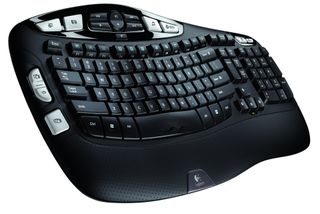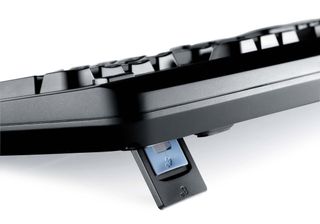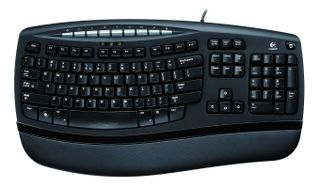Ergonomic Gear For A Better Life
Part 2: Keyboards, mice, and everything nice in between to help save your body from the pain associated with bad postures and designs.
Logitech Wireless Keyboard K350
Perhaps not surprisingly, the K350 keyboard turned out to be my personal favorite. It almost seems that Logitech studied Microsoft’s 5000 keyboard, took some inspiration from the 4000, added a few tweaks of its own, and delivered the company’s one and only ergonomic consumer keyboard. That may sound negative, but it’s not meant to be. I’ve reviewed and interviewed Logitech for many years, and the company’s pattern has always been to identify large trends in consumer peripherals, then figure out ways to build products for those trends that are attractive, offer feature-solid build quality, and deliver top-tier performance for mid-level prices. Take your pick of speakers, Webcams, mice—whatever. The pattern repeats over and over.

So it goes with the K350 ($60). Logitech obviously wanted an ergonomic keyboard with zero learning time. We have the same smile-shaped primary keybed found in the Microsoft 5000, only Logitech hasn’t monkeyed with the key size or (as far as my eye can perceive) key spacing. This is a nifty trick, and it makes moving from a standard keyboard to the K350 virtually seamless.
Actually, Logitech doesn’t draw from Microsoft’s 4000, despite possible appearances. The 4000, as stated before, uses a sloping keybed to reduce forearm pronation. The K350 does not. Instead, it actually takes a clue from contour-style keyboards and implements shallow dips in the plane of the keybed so as to better conform to the length of your fingers. The effect is slight but (presumably) cumulative. Fewer inches traveled overall means less repetitive motion.
I mentioned Logitech’s keyboard foot design earlier. As you can see in the photo here, there are two feet on each side of the keyboard, one nestled inside the other. This gives you the freedom to select an upward tilting angle of either four or eight degrees. But unlike Microsoft, Logitech doesn’t provide for tilting from the front edge, so there’s no help for wrist extension and, if anything, a danger of increasing it.

That said, I find that Logitech’s tactile feel is about the same as Microsoft’s, although Microsoft tends to be a bit quieter. (This may not be a good thing if you depend in part on auditory feedback to know that you’ve actually depressed a key.) As with Microsoft, Logitech’s 2.4 GHz wireless communication works like a champ, and the tiny USB receiver for both compatible keyboards and mice is ridiculously small—almost too small for mobile use since it’s about the size of a quarter and just as easily lost. Of course, the whole point is that it’s so small you’ll never need to unplug it. The stated three-year battery life for two AA cells, if true, is also outstanding.
I liked the comfort and quality of the K350 so much that I opted to make it my new primary keyboard, but part of that has to do with how I don’t have the time right now to adapt to a new keyboard style, which essentially means learning to touch type. If I were smarter, I’d force myself to make a better decision with more long-term benefits for my body. My suggestion is to do as I say, not as I do.

And hey, want a tip? If you don’t care about all of the K350's media function keys, and you’d rather avoid having even more wireless interference around your desk, save $20 and go buy the Logitech Comfort Wave 450. Same keyboard, only corded and slanted to business buyers.
Sign up to get the BEST of Tom’s Guide direct to your inbox.
Upgrade your life with a daily dose of the biggest tech news, lifestyle hacks and our curated analysis. Be the first to know about cutting-edge gadgets and the hottest deals.
Current page: Logitech Wireless Keyboard K350
Prev Page Microsoft Natural Ergonomic Keyboard 4000 Next Page The Kinesis AdvantageWilliam Van Winkle is a freelance editor and tech journalist who has been writing for more than 20 years. His work has appeared on Tom's Guide, Tom's Hardware, Tom's IT Pro, AMD, Seagate, Computer Shopper, and more. He is also an author, writing poetry, short stories, and science fiction and fantasy books.
-
Luscious I'm quite surprised your focus is on ergonomics yet you haven't mentioned anything at all about trackballs. I've been using a Logitech Track Man Wheel for close to 4 years paired with my notebook. They have many advantages over mice, not the least being ergonomically superior.Reply -
Supertrek32 I've been using the Microsoft Natural Ergonomic Keyboard 4000 for a few years now and must say that I love it. Very comfortable. I also reprogrammed the back/forward buttons to control media player (via Microsoft's intellitype software), which is incredibly hand for someone like me who has a large music collection and might not be in the mood for a certain genre one day.Reply -
IzzyCraft ryanegeigerI agree... what about trackballs?trackballs are perfect for work only situations esp with limited desk space.Reply -
ddrcoder I've used a Kinesis for years (I'm typing this with one right now), and I must say they're the best keyboards ever made. I've found that they relieved stress in my hands/wrists. I recommended them to a friend who couldn't touch type and as he got used to the keyboard, he quickly learned. He can now type at 60WPM, I can type at 100WPM.Reply
-Tom -
Trackballs, why have they been blackballed? Everyone I loan my spare, I have three new ones just in case they stop selling them, Logitech mouse man marble to they immediately buy one for themselves.Reply
My friend has CTS and cannot use a regular mouse with one hand because of the strain, trackball fixed him right up. Not only are they friendlier on the wrist the require vastly less desk space, they are easier to control and for precision work nothing beats a trackball.
My Gaming (counterstrike: source, UT2004, UT3, half life, team fortress, day of defeat,etc) buddies all have crazy expensive uber dpi programmable gaming mice that have lasers, and my 20$ trackball whips 'em every time. Why? no wasted movement, my arm is completely stationary when mousing, my fingers can keep the ball fluid and moving in one direction without having to lift it up, move it ove,r set it down, and continue mousing, one quick flick of the finger and the ball goes spinning in the desired direction, all while my arm is relaxed and stationary.
They are in fact perfect in play situations too.
How about some trackball love? -
coconutboy I like these kinds of articles. Currently I own a logitech MX Revolution, it's my ~5th logi mouse (I also own a cordless logitech trackball), but really all these have just been because I couldn't find anything better including the gazillion specialized ergo mice on the market. I just wish someone would make an upright/joystick-like mouse that also includes-Reply
a trackball
scroll wheel or similar device
4 buttons minimum (5+ preferred) that users can define as forward/back/whatever.
I've tried many mice including the 3M joystick, Zero Tension Mouse and Evoluent upright. Those were somewhat better in terms of comfort but sacrificed buttons/functionality. As a result my last 4 or so mice have all been Logitech with my current being the MX Revolution but that's because of the extra buttons and its awesome scroll wheel, NOT the comfort which is just average.
William Van WinkleI was able to try out Logitech’s MK605 notebook kit ($100)... The keyboard and mouse are okay, and they are decently compact for travel, but I wish the stand were available separately.
The stand can be purchased individually for $30. Linkage-
http://www.logitech.com/index.cfm/notebook_products/stands/devices/5494&cl=us,en
-
williamvw The stand can be purchased individually for $30. Linkage-http://www.logitech.com/index.cfm/ 4&cl=us,enReply
Oh, bonus! Thanks for pointing that out, coconutboy. Again -- highly recommended. -
tapeglue Less known help for wrist pain can be a computer armrest. I have been using one called Restman 1 for a few months now and it indeed makes me forget about my wrist problem. I got it from http://restmans.myshopify.com/products/restman-1.Reply -
trifler I find that mice with higher dpi allow me to turn up the speed without losing any of the control. This greatly reduces the amount of necessary wrist movement to use a mouse. Therefore, I actually choose the Logitech G500 (5700dpi) for ergonomic reasons rather than for gaming reasons.Reply
